12.1.4: The Chain Reaction of Agriculture
- Last updated
- Save as PDF
- Page ID
- 136459
While it may be hard to imagine today, for most of our species’ existence we were nomadic: moving through the landscape without a singular home. Instead of a refrigerator or pantry stocked with food, we procured nutrition and other resources as needed based on what was available in the environment. Instead of collecting and displaying stuff, we kept our possessions at a minimum for mobility. This part gives an overview of how this foraging lifestyle enabled the expansion of our species, then describes the invention of a new way of life, causing a chain reaction of cultural change taking us to the present day and beyond.
The Foraging Tradition
To understand our species is to understand foraging, or the search for resources in the environment. This subsistence strategy, or method of finding sustenance, sounds unusual to most of us today. Most of us live in cultures that practice another strategy, agriculture, where we shape the environment to mass produce what we need. Considering the age of modern Homo sapiens, however, we have spent far more time as nomadic foragers than as settled agriculturalists. As such, our traits have evolved to be primarily geared toward foraging. For instance, our efficient bipedalism allows persistence-hunting across long distances as well as movement from resource to resource. Even our psychological tendency toward our ability to form stable relationships with around 150 people (Dunbar 1993) may derive from the foraging lifestyle.
How does human foraging, also known as hunting and gathering, work? Anthropologists have used all four fields to answer this question (see Ember n.d.). Typically, people formed bands, or groups of around 50, and rarely over 100. A band’s organization would be egalitarian, with a flexible hierarchy based on an individual’s age, level of experience, and relationship with others. Everyone would have a general knowledge of the skills assigned to their gender roles, rather than specializing in different occupations. A band would move from place to place in the environment, using knowledge of the area to hunt and gather (Figure 12.25). While there were exceptions, women typically gathered plants and hunted small animals while men hunted larger prey where present (Waguespack 2005). The ratio of plant to meat in one’s diet would have depended on the local resources. As a location’s resources became used up, and as human waste accumulated, the band would travel to another patch (Venkataraman et al. 2017). In the varied environments that humans entered—from savannas to tropical forests, deserts, coasts, and the Arctic circle—people found sustenance needed for survival. Our species’s omnivorous and cultural ability led us to excel in the generalist-specialist niche. People could have temporarily altered their environment to be more productive, such as by burning foliage to spur new growth. Besides food sources, people would have known the local areas to find rock and wood suitable for tool production, and ochre for decoration. Bands could have formed trading connections to acquire goods from distant areas. Certain sites could have been gathering spots for local bands to trade, socialize, and worship, though they were not typically large permanent settlements.
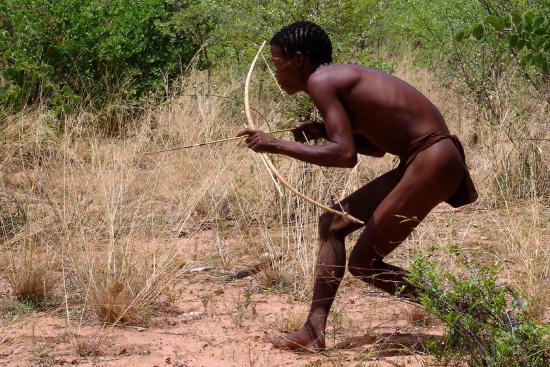 Figure \(\PageIndex{1}\): A present-day San man in Namibia demonstrates hunting using archery. Anthropologists still study the San today to learn about the foraging lifestyle in Africa.
Figure \(\PageIndex{1}\): A present-day San man in Namibia demonstrates hunting using archery. Anthropologists still study the San today to learn about the foraging lifestyle in Africa.Humans made extensive use of the foraging subsistence strategy, but this lifestyle did have limitations. The ease of foraging depended on the richness of the environment. Due to the lack of storage, resources had to be dependably found when needed. While a bountiful environment would require just a few hours of foraging a day, the level and duration of labor increased greatly in poor or unreliable environments. Labor was also needed to process the acquired resources, contributing to filling the foragers’ daily schedule (Crittenden and Schnorr 2017).
The adaptations to foraging found in modern Homo sapiens may explain why our species became so successful both within Africa and in the rapid expansion around the world. Overcoming the limitations, each generation at the edge of our species’s range would have found it beneficial to expand a little further, keeping contact with other bands but moving into unexplored territory where resources were richer. The cumulative effect would have been the spread of modern Homo sapiens across continents and hemispheres.
Why Agriculture?
After hundreds of thousands of years of foraging, some groups of people around 12,000 years ago started to practice agriculture instead. This transition is called the Neolithic Revolution, and it occurred at the start of the Holocene epoch. The reasons for this global change are still being investigated, but there are two likely causes that may have occurred together: a growing human population and natural global climate change.
Overcrowding could have affected the success of foraging in the environment, leading to the development of a more productive subsistence strategy (Cohen 1977). Foraging works the best with low population densities since each band needs a lot of space to support itself. If too many people occupy the same environment, they would deplete the area faster. The high population could exceed the carrying capacity, or number of people a location can reliably support. For instance, what if a band arrived at a grove of nutritious plants they were depending on, but it had already been used by other groups? Then the late arrivals are suddenly in a dire situation without the food they were depending on finding. This situation on a global level due to growing population and limited areas of expansion would have been an increasingly pressing issue after the human expansion through the major continents by 14,600 years ago.
A changing global climate immediately preceded the transition to agriculture, so researchers have also explored a connection between the two events. Since the Last Glacial Maximum of 23,000 years ago, the Earth slowly warmed. At 13,000 years ago, the temperature in most of the Northern Hemisphere dropped suddenly in a phenomenon called the Younger Dryas. Glaciers returned in Europe, Asia, and North America. In Mesopotamia, which includes the Levant, the climate changed from warm and humid to cool and dry. The change would have occurred over decades, disrupting the usual nomadic patterns and subsistence of foragers around the world. The Younger Dryas lasted until 11,700 years ago, when the climate returned to the long-term warming pattern. The disruption to foragers due to the temperature shift could have been a factor in spurring the transition to agriculture. Researchers Gregory K. Dow and colleagues (2009) believe that foraging bands would have clustered in the new resource-rich places where people started to direct their labor to farming the limited area. Continued practice would prompt innovations such as better tools and increasing productivity. After the Younger Dryas ended, people expanded out of the clusters. As they reinhabited the region, they brought with them a culture in which farming had become the norm, along with the technology and knowledge to succeed with this subsistence strategy (Figure 12.26).
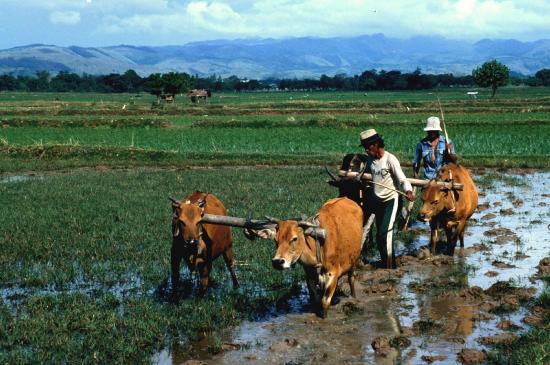 Figure \(\PageIndex{2}\): Rice farmers in the present day using draft cattle to prepare their field.
Figure \(\PageIndex{2}\): Rice farmers in the present day using draft cattle to prepare their field.The double threat of the limitation of human continental expansion and the sudden global climate change may have placed bands in peril as more populations outpaced their environment’s carrying capacity. Not only had a growing population led to increased competition with other bands, but environments worldwide shifted to create more uncertainty. As people in different areas around the world faced this chaotic situation, they became the independent inventors of agriculture.
Agriculture around the World
Due to global changes to the human experience starting from 12,000 years ago, cultures with no knowledge of each other turned toward farming their local resources (Figure 12.27). The switch to agriculture took time and effort with no guarantee of success. Agriculture is a difficult process with fires, floods, droughts, disease, and pests being constant problems to address. Heavy physical labor with no immediate payoff was also needed to shape the landscape in a coordinated way to support agriculture. For example, people had to direct water flow to irrigate constructed fields of crops. The first farmers also engaged in artificial selection of their domesticates to enhance useful traits. The biggest success stories in the face of these obstacles became the primary centers of agriculture (Figure 12.27) (Fuller 2010):
- Mesopotamia: The Fertile Crescent from the Tigris and Euphrates rivers through the Levant was where bands started to domesticate plants and animals around 12,000 years ago. The connection between the development of agriculture and the Younger Dryas was especially strong here. Farmed crops included wheat, barley, peas, and lentils. This was also where cattle, pigs, sheep, and goats were domesticated.
- South and East Asia: Multiple regions across this land had varieties of rice, millet, and soybeans by 10,000 years ago. Pigs were farmed with no connection to Mesopotamia. Chickens were also originally from this region, bred for fighting first and food second.
- New Guinea: An under-appreciated center in Melanesia, agriculture started here 10,000 years ago. Bananas, sugarcane, and taro were native to this island. Sweet potatoes were brought back from voyages to South America around the year C.E. 1,000. No known animal farming occurred here.
- Mesoamerica: Agriculture from Central Mexico to northern South America also occurred from 10,000 years ago; it was also only plant based. Maize was a crop bred from teosinte grass, which has become one of the global staples. Beans, squash, and avocados were also grown in this region.
- The Andes: Starting around 8,000 years ago, local domesticated plants started with squash but later included potatoes, tomatoes, beans, and quinoa. Maize was brought down from Mesoamerica to join the local variety. The main farm animals were llamas, alpacas, and guinea pigs.
- Sub-Saharan Africa: This region went through a change 5,000 years ago called the Bantu expansion. The Bantu agriculturalists were established in West Central Africa and then expanded south and east. Native varieties of rice, yams, millet, and sorghum were grown across this area. Cattle were also domesticated here.
- Eastern North America: This region was the last major independent agriculture center, from 4,000 years ago. Squash and sunflower are the produce from this region that are most known today, though sumpweed and pitseed goosefoot were also farmed. Hunting was still the main source of animal products.
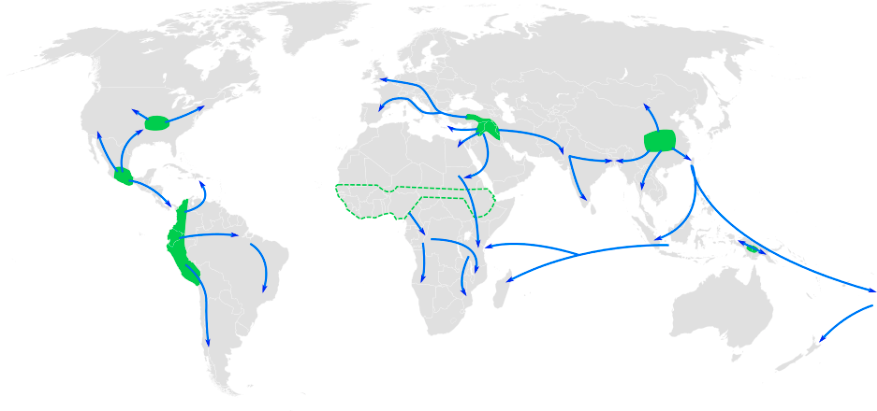 Figure \(\PageIndex{3}\): Map showing the areas where agriculture was independently invented around the world. The dotted line around sub-Saharan Africa represents a possible range that is still being narrowed by research. Blue arrows show the spread of agriculture from these zones to other regions.
Figure \(\PageIndex{3}\): Map showing the areas where agriculture was independently invented around the world. The dotted line around sub-Saharan Africa represents a possible range that is still being narrowed by research. Blue arrows show the spread of agriculture from these zones to other regions.By 5,000 years ago, our species was well within the Neolithic Revolution. From the primary centers, agriculturalists spread to neighboring parts of the world with their domesticates, further expanding the use of this subsistence strategy. For example, the Mesopotamian farmers spread their innovations along the northern coast of the Mediterranean into Europe (Pinhasi, Fort, and Ammerman 2005). The crops of China were brought into the Korean peninsula (Lee 2011). From this point, the human species changed from being primarily foragers to primarily agriculturalists. The revolution took millennia, but it was a true revolution in that the lifestyle of our species was reshaped to something vastly different.
Cultural Effects of Agriculture
The worldwide adoption of agriculture altered the course of human culture and history forever. The foraging lifestyle was incompatible with agriculture, so dependence on the latter required huge changes in how people lived. This section starts by following the human developments that occurred due to agriculture, leading us from 12,000 years ago to the present day. We will also reconnect with modern foragers to see how their lives have changed.
The core change in human culture due to agriculture is the move toward not moving: rather than live a nomadic lifestyle, farmers had to remain in one area to tend to their crops and livestock. The term for living bound to a certain location is sedentarism. Remaining in one place led to aspects of life that were uncommon in foragers: the construction of permanent shelters and agricultural infrastructure such as fields and irrigation, plus the development of storage technology such as pottery to preserve extra resources in case of future instability.
The high productivity of successful agriculture sparked further changes (Smith 2009). Since successful agriculture produced a much greater amount of food and other resources per unit of land compared to foraging, the population growth rate skyrocketed. The surplus of a bountiful harvest also provided insurance for harder times, reducing the risk of famine. Changes happened to society as well. With a few farming households producing enough food to feed many others, other people could focus on other tasks. So began specialization into different occupations such as craftspeople, traders, religious figures, and artists, spurring innovation in these areas as people could now devote time and effort toward specific skills. These interdependent people would settle an area together for convenience, causing a rise in the number of dense populations focused around farms, water, and trade routes. The growth of these settlements led to urbanization, the founding of cities that became the foci of human interaction.
 Figure \(\PageIndex{4}\): View of downtown San Diego taken by the author at a shopping complex during a break from jury duty. Here, people live amongst structures that facilitate commerce, government, and art.
Figure \(\PageIndex{4}\): View of downtown San Diego taken by the author at a shopping complex during a break from jury duty. Here, people live amongst structures that facilitate commerce, government, and art.The formation of cities led to new issues that sparked the growth of further specializations, called institutions. These were cultural constructs that existed beyond the individual and had wide control over a population. Leadership of these cities became hierarchical with different levels of rank and control. Laws influenced the behavior of citizens, establishing ideal behavior and punishment for deviations. Organized religion also kept followers under a standard set of beliefs and values tied to spirituality. Under leadership, people built impressive monumental architecture such as pyramids that embodied the wealth and power of these early cities. Alliances could unite cities, forming the earliest states. In several regions of the world, state organization expanded into empires, wide-ranging political entities that covered a variety of cultures.
Urbanization brought new challenges as well. The concentration of sedentary peoples was ideal for infectious diseases to thrive since they could jump from person to person and even from livestock to person (Armelagos, Brown, and Turner 2005). Urban life also caused sanitation problems as human waste accumulated, adding to the spread of disease. While successful agriculture provided a large surplus of food to thwart famine, the variety of food produced was smaller than what foragers experienced (Cohen and Armelagos 1984; Cohen and Crane-Kramer 2007). The dependence on high-yield crops also caused an overabundance of carbohydrates in the diet of agriculturalists. This shift in nutrition caused another set of diseases to flourish among those who adopted farming as their subsistence strategy: dental issues such as dental caries (the cavities that ruin your visit to the dentist) and malocclusion (the misalignment of teeth caused by the softness of agricultural diets). The issues with “wisdom teeth” or third molars seen in agricultural cultures today stems from this misalignment between the environment our ancestors adapted to and our lifestyles today.
As the new disease trends show, the adoption of agriculture and the cultural changes that followed were not entirely positive. It is also important to note that this is not an absolutely linear progression of human culture from simple to complex and that higher complexity is not necessarily better than lower complexity. In many cases empires have collapsed and cities have dispersed to low-density bands that no longer saw use in maintaining institutions. However, a global trend has emerged since the adoption of agriculture, wherein population and complexity have increased, leading to the massive and influential nation states of today.
The rise of states in Europe has a direct impact on many of this book’s topics. Science started as a European cultural practice by the upper class that became a standardized way to study the world. Education became an institution to provide a standardized path toward producing and gaining knowledge. The scientific study of human diversity, embroiled in the race concept that still haunts us today, was connected to the European slave trade and colonialism.
Also starting in Europe, the Industrial Revolution of the 19th century turned cities into centers of mass manufacturing and spurred the rapid development of inventions. In the technologically interconnected world of today, human society has reached a new level of complexity with globalization. In this system, goods are mass produced and consumed in different parts of the world due to worldwide economic factors. Instead of relying on local farms and factories, we now receive our everyday goods from all over the world.
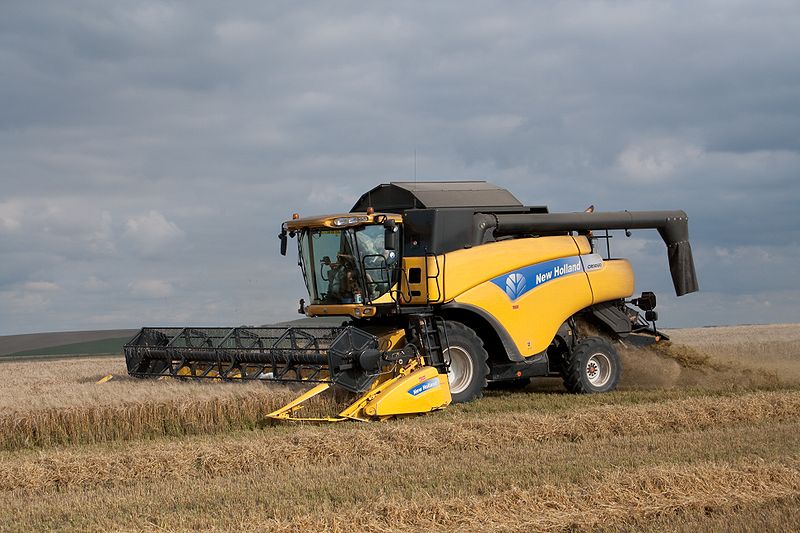 Figure \(\PageIndex{5}\): This combine harvester can collect and process grain at a massive scale. Our food now commonly come from enormous farms located around the world.
Figure \(\PageIndex{5}\): This combine harvester can collect and process grain at a massive scale. Our food now commonly come from enormous farms located around the world.As states based on agriculture and industry keep exerting influence on humanity today, there are people who continue to live a foraging—or mostly foraging—lifestyle. Due to the overwhelming force that agricultural societies could exert, foragers today have been marginalized to live in the least habitable parts of the world (Headland et al. 1989). These are places that are the worst for farmland, such as tropical rainforests, deserts, and the arctic. Foragers can no longer live in the abundant environments that humans would have enjoyed before the Neolithic Revolution. Interactions with agriculturalists are typically imbalanced, with trade and other exchanges heavily favoring the larger group. One of anthropology’s important roles today is to intelligently and humanely manage interactions between people of different backgrounds and levels of influence.
The Future of Humanity
This chapter covered what modern Homo sapiens has done to get to the present time, but what will our species do far in the future? Just as biological changes accumulated from over 300,000 years ago to today, what will human traits and genetics be like? When posed with these questions, people tend to think of directional selection. Maybe our braincases will be even larger, resembling the large-headed and small-bodied aliens of science fiction (see figure 12.30. Or, our hands could be specialized for interacting with our touch-based technology with less risk of repetitive injury. These ideas do not stand up to scrutiny. Since natural selection is based on adaptations that increase reproductive success, any directional change must be due to a higher rate of producing successful offspring compared to other alleles. Larger brains and more agile fingers would be convenient to possess, but they do not translate into an increase in the underlying allele frequencies.
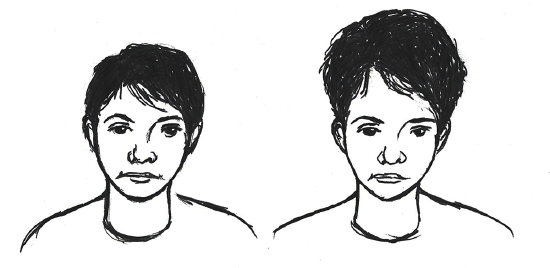 Figure \(\PageIndex{6}\): Will we evolve toward even more globular brains? Actually, this trend is not likely to continue for our species.
Figure \(\PageIndex{6}\): Will we evolve toward even more globular brains? Actually, this trend is not likely to continue for our species.Scientists are hesitant to professionally speculate on the unknowable, and we today will never know what is in store for our species a thousand or a million years from now, but there are trends in human evolution that may carry on into the future. These trends are increased genetic variation and a reduction in regional differences.
Rather than a directional change, genetic variation in our species could expand. Our technology can protect us from extreme environments and pathogens, even if our biological traits are not tuned to handle these stressors. The rapid pace of technological advancement means that biological adaptations will become less and less relevant to reproductive success, so non-beneficial genetic traits will be more likely to remain in the gene pool. Biological anthropologist Jay T. Stock (2008) views environmental stress as needing to defeat two layers of protection before affecting our genetics. The first layer is our cultural adaptations. Our technology and knowledge can cover for many of our biological issues, reducing pressure on one’s genotype to be just right to pass to the next generation. The second defense is our flexible physiology, such as our functional adaptations. Only stressors not handled by these powerful responses would then cause natural selection on our alleles. These shields are already substantial, and cultural adaptations will only keep increasing in strength.
The increasing ability to travel far from one’s home region means that there will be a mixing of genetic variation on a global level in the future of our species. In recent centuries, gene flow of people around the world has increased, creating admixture in populations that had been separated for tens of thousands of years. For skin color, this means that populations all around the world could exhibit the whole range of skin colors, rather than the current pattern of decreasing melanin pigment farther from the equator. The same trend of intermixing would apply to all other traits, such as blood types. While our genetics will become more varied, the variation will be more intermixed instead of regionally isolated.
Our distant descendants will not likely be dextrous ultra-intellectuals; more likely, they will be a highly variable and mobile species. They will be supported by cultural adaptations that we cannot even imagine, making up for any biological limitations that keep getting passed to the next generation. Technology may even enable the editing of DNA directly, changing these trends. With the uncertainty of our future, these are just the best educated guesses for now. Our future is open and will be shaped little by little by our actions and those of our descendants.

